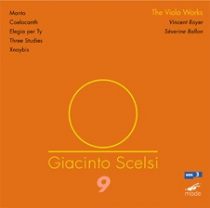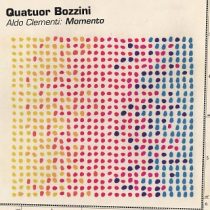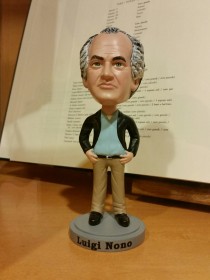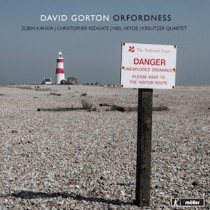Managing Editor Grant Chu Covell works in the Boston area. He once worked for a global technology company that made hardware which Xenakis and Babbitt used to good effect. He was the publisher of the brilliant but forgotten The Periodic Journal of Bibliography (1990-95), and his music reviews have appeared in EAR Magazine and InMusic. His instrumental and electroacoustic music has been performed in the U.S. and abroad, and he has shared many CDs of his music with family and friends (one piece was recorded in a refrigerator). A short article about a composition he wrote for piano and tape can be found in the Csound Magazine. Two electroacoustic works have appeared in commercial compilations: Presence III and The Door Project. A recent CD can be found here, and another is in preparation. A long departed family dog’s name was taken from a character in Wagner’s Ring.
Grant Chu Covell

Mostly Symphonies 28: Untangling Schnittke
For a full 48 minutes, there’s nothing ambiguous here, nothing that suggests its composer could command many styles and would with apparent frivolity combine them in the same work.

Mostly Symphonies 28: Untangling Schnittke
For a full 48 minutes, there’s nothing ambiguous here, nothing that suggests its composer could command many styles and would with apparent frivolity combine them in the same work.

String Theory 21: Mostly Viola(s)
Royer is an inspired Scelsi performer. He plays as if improvising, easing into Scelsi’s languid microtones with grace notes flicked away like involuntary twitches.

String Theory 21: Mostly Viola(s)
Royer is an inspired Scelsi performer. He plays as if improvising, easing into Scelsi’s languid microtones with grace notes flicked away like involuntary twitches.

Piano Factory 17.
Craven provides only pitches and permits repetitions, octave displacement, variable dynamics, etc.

Piano Factory 17.
Craven provides only pitches and permits repetitions, octave displacement, variable dynamics, etc.

String Theory 20: Mostly Violin (with Piano Accompaniment)
With coarse harmonies and a rhythmic engine requiring a few cranks before it hums, the two-movement Sonata emerges brooding and severe, wonderfully modern and unfamiliar.

String Theory 20: Mostly Violin (with Piano Accompaniment)
With coarse harmonies and a rhythmic engine requiring a few cranks before it hums, the two-movement Sonata emerges brooding and severe, wonderfully modern and unfamiliar.

String Theory 19: Mostly Cello
Pieces requiring retuning or scordatura have a modest foothold in the literature. It is very unusual to encounter works where strings are adjusted while playing, but several specimens fill out Ballon’s bold recital.

String Theory 19: Mostly Cello
Pieces requiring retuning or scordatura have a modest foothold in the literature. It is very unusual to encounter works where strings are adjusted while playing, but several specimens fill out Ballon’s bold recital.

Piano Factory 16. / (Dis)Arrangements 9: Liszt and Wagner
Liszt’s last pieces reflect little interest in pyrotechnics or showy glamour. They are curious about harmony and the spiritual world; some touch on historical subjects, but most all are reflective, even world-weary.

Piano Factory 16. / (Dis)Arrangements 9: Liszt and Wagner
Liszt’s last pieces reflect little interest in pyrotechnics or showy glamour. They are curious about harmony and the spiritual world; some touch on historical subjects, but most all are reflective, even world-weary.

(Dis)Arrangements 8: More Schubert
Schubert left no concertos, but we do have Liszt’s overstuffed quasi-symphonic Fantasy for piano and orchestra.

(Dis)Arrangements 8: More Schubert
Schubert left no concertos, but we do have Liszt’s overstuffed quasi-symphonic Fantasy for piano and orchestra.

Italian Vacation 14.
To say Aldo Clementi uses canons, is like saying Wagner wrote operas or that Beethoven was good at variations.

Italian Vacation 14.
To say Aldo Clementi uses canons, is like saying Wagner wrote operas or that Beethoven was good at variations.

Italian Vacation 13.
In Verrando’s universe, noise enriches but does not obliterate.

Utopian Listening: Reinvigorating Nono in America
Years from now, we will look back at a conference held in Boston at the end of March 2016 as the defining event that reinvigorated worldwide – American especially – interest in the work of Luigi Nono.

Utopian Listening: Reinvigorating Nono in America
Years from now, we will look back at a conference held in Boston at the end of March 2016 as the defining event that reinvigorated worldwide – American especially – interest in the work of Luigi Nono.

(Dis)Arrangements 7: Beethoven
This Ninth is fascinating, hugely musical, a testament to Beethoven and Liszt’s combined brilliance.

(Dis)Arrangements 7: Beethoven
This Ninth is fascinating, hugely musical, a testament to Beethoven and Liszt’s combined brilliance.

String Theory 18: Bundled Quartets and a few Trios
I imagine that Gorton enjoys a good joke. In Fosdyke Wash, a sighing cello part is marked “like distant agricultural machinery.” At that point, the cello sounds like a mewling chainsaw at a far remove.

String Theory 18: Bundled Quartets and a few Trios
I imagine that Gorton enjoys a good joke. In Fosdyke Wash, a sighing cello part is marked “like distant agricultural machinery.” At that point, the cello sounds like a mewling chainsaw at a far remove.